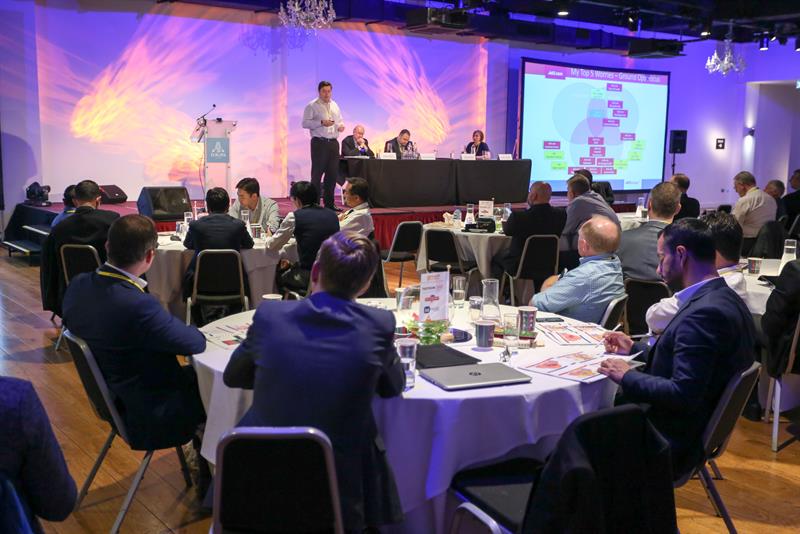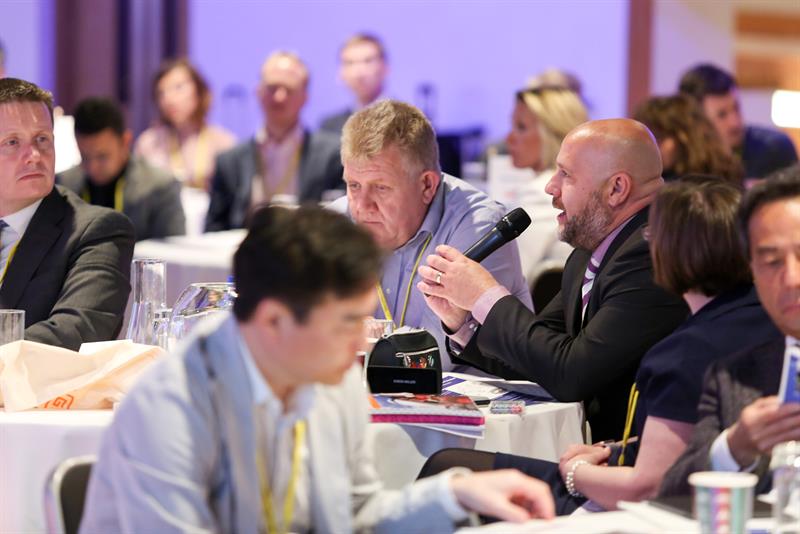
Indeed, safety tops the agenda in many other industries besides, confirmed by Robert Lindsay of Balfour Beatty and Tunnelling consultant Brian Earnshaw, who came along to share their perspectives on promoting safer operations in the workplace. Both emphasised the role of training, supervision and encouraging individual responsibility through a Just Culture as paramount to the continuous improvement of safety – themes that were consistent throughout the event.
Using your brain
Dabbling in the field neuroscience, Martin Dean of DEKRA Insight informed delegates about the impact of ‘fast-brain’, the economical mindset that hinders our perception of change in familiar environments. “SOPs are not written the way the brain reads,” delegates heard – but how do employees switch from ‘fast-brain’ mode and overcome this? “Mindful monitoring,” was Dean’s answer. “You’ve got to consciously switch ‘slow-brain’ on,” he remarked, adding that SOPs should be rewritten to accommodate speedier interpretation.
Delving into Serious Injury and Fatality potential, Dean emphasised that reducing incidents with low SIF potential will not reduce overall fatality rates. “Covering your hot coffee with a lid won’t stop people dying,” he said pointedly, concluding that a new investigative paradigm is needed that is proportionate to SIF potential, not OTP-focused and that identifies the root causes of incidents. “No forms,” he added. “Forms force us to fill in boxes. If we don’t have boxes, we think outside the box.”
Maintain – and gain
Discussion of the ‘no touch’ policy heard Jason Sandever, CAA, and Kevin Daws, Airtanker Services, bemoaning the continued oversight of crucial GSE maintenance. The pair relayed a worrying account of a decommissioned set of steps, deemed unfit for purpose, found in use on the ramp - having gone without vital servicing for two years. More amusing was the case of a handler that replaced the black rubber bumpers on its passenger steps with white ones, in a misguided attempt to avoid leaving black marks on aircraft...
Tim Rane, MD of Air GSE, commented on the occurrence of incidents involving GSE that had had faulty or counterfeit repairs and asked, how do we overcome this? Of the solutions, age limits and CAP642 testing were discussed, with two examples being London Heathrow’s 15-year age limit and Manchester airport’s CAP642 annual MOT. Age limits are a barrier to new entrants, however, and new thinking needs to be applied. Considering the total profit of ownership, as opposed to total cost, will be beneficial in this regard: “Companies that penny pinch on maintenance are the ones with poor safety records,” Rane asserted, impressing that maintaining a young age profile is key. Yves Crespel of TLD concurred. “Poor maintenance practices create liability for the equipment owner,” he told delegates – and while maintenance can be delayed without obvious immediate financial impact, the stakes are high if something goes wrong. “Maintenance, if well done, is a competitive advantage, generates better use and residual value,” Crespel asserted.

Who is in charge?
Near-miss events provide a wealth of opportunity for learning and improvement, said Maurizio Anichini and Brenda Aremo-Anichini in their safety masterclass. Fear keeps us on our toes but the fear factor fades in long-serving employees to be replaced by complacency. The question of who is responsible for safety at the bay highlighted a divide in attitudes, with answers varying from SMS co-ordinator to the TRC, leading Aremo-Anichini to ask: “If you need support, do you know who to go to for guidance?” Organisational structures should be designed with a clear line of accounting and reporting from the top to the bottom, Aremo-Anichini advised, adding that it is critical that someone is assigned overall responsibility – and that they have complete oversight of the operation.
Divulging various examples of the risks at each operational phase, Aremo-Anichini emphasised that near-miss events, as well as actual incidents, should be investigated. “Structure your approach, translate this to data and then channel it through the right management avenues,” she concluded of the best way to improve following mistakes.
Sleepless nights
Steve Szalay of Jet2 and Stuart Carmichael, Menzies, aired the top concerns keeping them awake at night. Airline and handler concurred on the major worries, which included loading errors, unreported damage, aircraft ingestion and personal injury. Szalay reported that Jet2 has addressed all of its severest threats – and areas for improvement. “We’re measuring stuff not just because we can but because it’s important,” he said, citing Jet2’s new practice of measuring the time take to process the final bag tag rather than the first one. Carmichael impressed the importance of a Just Culture at Menzies and the role this plays in safety, remarking openly on the 2015 Alaska Airlines incident in which a Menzies ramp worker fell asleep in the hold of an aircraft. This served as a prime example of importance of a Just Culture and the subsequent threat that is posed to safety when workers feel unable communicate concerns, such as fatigue, with their superiors.
Fighting fatigue In keeping with the role of human factors, Dr Sarah Flaherty of Clockwork Research conveyed the implications of the sleep deprivation that is characteristic of shift work – the staple diet of the ramp worker. “After 17 hours of wakefulness, performance is equivalent to having a blood alcohol level of 0.05% and response times are 50% slower,” she relayed, “and you wouldn’t ask somebody to get behind the wheel drunk.” Explaining that lack of sleep can contribute to various health issues in addition, Flaherty stressed that ignoring this prevalent issue is not an effective risk management method and employers have a responsibility to protect the well-being of their staff. “Don’t see fatigue as a weakness but as a hazard,” she said, adding that attitudes surrounding fatigue need to change to more closely align with those of pilot community, where this basic human need is very much respected.
In keeping with the role of human factors, Dr Sarah Flaherty of Clockwork Research conveyed the implications of the sleep deprivation that is characteristic of shift work – the staple diet of the ramp worker. “After 17 hours of wakefulness, performance is equivalent to having a blood alcohol level of 0.05% and response times are 50% slower,” she relayed, “and you wouldn’t ask somebody to get behind the wheel drunk.” Explaining that lack of sleep can contribute to various health issues in addition, Flaherty stressed that ignoring this prevalent issue is not an effective risk management method and employers have a responsibility to protect the well-being of their staff. “Don’t see fatigue as a weakness but as a hazard,” she said, adding that attitudes surrounding fatigue need to change to more closely align with those of pilot community, where this basic human need is very much respected.
Safety aids
A newer name in the industry, Textron Managing Director Lars-Gunnar Nilsson showcased Smart Sense, Textron’s latest sensor technology designed to limit vehicle speed based on proximity to the aircraft, thereby eliminating operator error. Further technological developments included AVoiD, unveiled by Dorel Picovici, Project Manager at the Institute of Technology, Carlow. AVoiD comprises proximity monitoring technology that records near-miss events. Video evidence collected by prototypes showed GSE making contact with the fuselage of the aircraft before backing away to allow for the ‘safety gap’. “Our job is to make you aware of this,” said Picovici, adding that the company is actively seeking investment to get its new technology off the ground.
Laurent Decoux presented on TLD’s innovative 3D camera technology that offers to make “seeing” rather than merely sensing a reality in the world of GSE. Through careful calculation and monitoring of external objects, TLD’s ASD technology could facilitate a future where GSE can adapt to its changing environment.
Lively discussion
Delegates heard of IATA’s decision to introduce the ISAGO New Operational Audit Model after deeming the current model ineffective, before a panel debated the conflicts of OTP versus safety. Are the two objectives mutually exclusive? Industry veteran Neale Millett led the debate, which addressed various competing factors such as the role of personal pride in getting the job done quickly, concern over lost profits resulting from missed OTPs and employee fears over incurring discipline for causing delays.
Overall, the two-day event was a resounding success, with presentations insightful and discussion both plentiful and productive – all in aid of securing safer operations for the future.
--------------------------------------------------------------------------------------------------------------------------------------------------------------
Delegate feedback
“A big thank you for staging such a successful conference. The attention to detail was second to none. We made some fantastic business connections.” Katrina Bradley, Institute of Technology, Carlow
“A good conference. Organisation (thanks to the team) location, program, meals, everything was perfect.” Michel Ragot, Pyramides – CSAE
“I just wanted to say thank you so much for inviting me to speak at the GHI Ground Damage Conference this week. I really enjoyed meeting all the other delegates and as always, the organisation was simply superb. Your conferences are always such a pleasure to attend.” Sarah Flaherty, Clockwork Research
---------------------------------------------------------------------------------------------------------------------------------------------------------------





